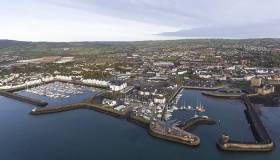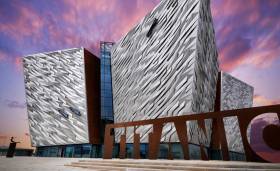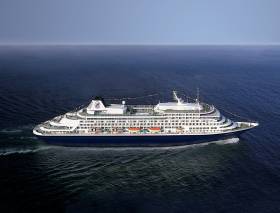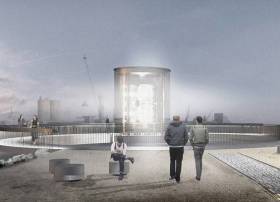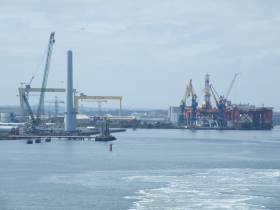Displaying items by tag: Belfast Lough
Belfast's Harland & Wolff Banks on ‘Holy Grail’ of Decommissioning
#Decommissioning - For many UK ports writes EnergyVoice, developing the facilities needed for large-scale decommissioning projects is a quest they are just embarking on.
But for the Belfast based Harland and Wolff (H&W) shipyard, the asset it describes as the Holy Grail of ship decommissioning has been in place for many years.
The yard that built the Titanic has one of the biggest dry docks in the world, at 556metres in length and 93metres wide, about the same area as seven Wembley football pitches.
David McVeigh, general manager, sales marketing and business development, said the dock is an important feather in Belfast’s cap.
Its thick, high walls are a physical barrier between the surrounding environment and oils and other contaminants that could accidentally spill. It keeps H&W in line with the 1992 Basel Convention on the transfer and disposal of hazardous waste materials.
Ports with piers or slipways may have well thought out safeguards against spills, but from an environmental viewpoint, they cannot offer the same level of assurance on decommissioning.
H&W also has a waste management licence for ship and offshore unit recycling, not to mention the two giant yellow cranes, Samson and Goliath.
Mr McVeigh said H&W’s offering means it should appeal to those who take their environmental responsibilities seriously. He said: “Our facilities are huge. We have big quaysides and one of the biggest dry docks in the world.
It means we can offer environmentally credible solutions. “Some customers would place the economics above the environmental impact. We’ll still see vessels going outside EU to places that are not as concerned about environmental issues as we are. If someone is looking for a cheap solution they’re not going to come to us, but if someone values the environment, we are well suited to deliver.”
Mr McVeigh said that while decommissioning is not a big earner for H&W, the yard will be “ready to go” when the market kicks into gear.
To date, perhaps the biggest decommissioning job H&W has handled was that of the MSC Napoli container ship (see Belfast coverage photo), which was beached in Lyme Bay in the English Channel in 2007. The job could quite easily serve as a dress rehearsal for the decommissioning of a floating production, storage and offloading vessel in the coming decades.
Dismantling topsides could be part of the mix, too. Mr McVeigh said H&W had carried out a dock appraisal to demonstrate that Allseas’ mammoth Pioneering Spirit, which will remove Shell’s Brent Delta platform in summer 2017, could work within the harbour’s existing facilities.
For more and also manufacturing installation project click here.
NATO Warships Visit Belfast Lough On Watch For Russian Vessels
#NavalVisits - The Royal Navy’s HMS Duncan was among a fleet of NATO warships that sailed into Belfast Lough on Friday 4 November, as ITV News reports.
The Type 45 Destroyer, only the second of its kind in Northern Ireland’s waters, is part of a four-ship fleet comprising frigates from Spain, Portugal and Germany that had been scheduled to visit last month.
However, they were diverted to monitor a number of Russian warships passing through British waters en route to Syria.
The visit this weekend followed reports that Russian submarines had been tracked through the Irish Sea in recent weeks, as previously covered on Afloat.ie.
Carrickfergus Marina Makes the Perfect Base to Explore
Sponsored content: Carrickfergus Marina situated on the northern shore of Belfast Lough is making the most of the current Euro-Sterling exchange rates to highlight its Five Gold Anchor facility, with 300 fully serviced berths, to sailors and boat owners considering a change of berth on the East Coast.
The County Antrim marina has a choice of flexible contracts, and new customers taking out their first contract will get their first month free on a complimentary basis. In particular, its Winter Berthing Contract is £112.20 per metre for the six month period from 1 October 2016 till 31 March 2017.
Those coming in from 1 November onwards will be given pro-rata of this price, and again each new customer will receive the same discount.
Facilities at Carrickfergus
Customers at Carrickfergus Marina can avail of a boat yard on site, with a 40-ton travel hoist, chandlery and guardianage services are also provided. There is also an onsite brokerage service, and the long-established sailing club, with an active racing and cruising section. Club racing at Carrickfergus runs from Easter through to mid-December.
Twenty-four-hour security should give you peace of mind, while the marina also provides a dedicated berth for contract holders, a post-holding service for those on the go, and free Wi-Fi to stay connected. An extensive site refurbishment is currently underway to revamp the marina’s electrics and access systems, and a new family bathroom with separate shower is due to open in late winter.

Travelling to Carrickfergus
By car: Carrickfergus Marina is just over two hours from Dublin via the M1 and A1 to Belfast, then the M5 and A2 north along Belfast Lough. Car parking is available adjacent to the east and west gates into the marina basin.
By bus/train: The marina can be reached from Dublin in around three hours, by coach from Dublin to Belfast city centre and then local services to the main road outside the marina office, or by rail from Dublin Connolly to Belfast Central and local train (approx 25 minutes) to Carrickfergus station, a three-minute walk from the marina.
Carrickfergus as a destination
Spend a weekend, or a week, in Carrickfergus exploring the town’s unique local heritage, including its Norman castle and renowned St Nicholas’ Church, both dating from the 12th century, as well as the local heritage museum and Flame Gasworks Museum – Ireland’s sole surviving coal gasworks, one of only three left in the British Isles.
Go for a swim or a workout in the state-of-the-art gym at the Amphitheatre Leisure Centre; browse the selection of boutique shops in the town centre; and enjoy a meal in one of the many fine local restaurants — all located within a five-minute walk of the marina.
To keep the family entertained, the Omniplex multiscreen cinema across the road which also offers reduced-price child-friendly and ASD-friendly showings during holidays and weekends, and there is a brand new soft-play centre two minutes’ drive away.
No spare cabin for friends or family? They can stay at one of the town’s comfortable local hotels. Premier Inn is right across the road, while Dobbins Inn is a five-minute walk on the town’s main street, and the four-star Loughshore Hotel is a two-minute drive from the marina.
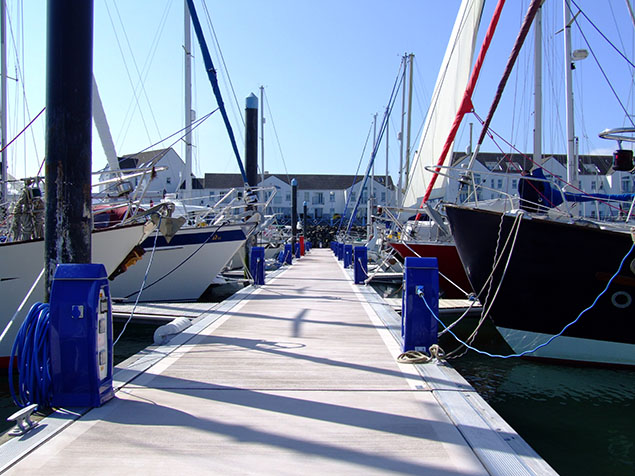
Contact details are as follows:
Carrickfergus Marina, Mid & East Antrim Borough Council, 3 Quayside, Carrickfergus, BT38 8BJ Telephone: 028 9336 6666
Website: www.midandeastantrim.gov.uk
Titanic Quarter Company Warns of Brexit Impact
#TitanicBrexit - Belfast’s Titanic Quarter, which is home to Northern Ireland’s and Europe's most popular tourist attraction, has reported losses for last year of £333,111 (€383,329), newly filed accounts show.
Titanic Island Limited, which controls the group of companies working in the quarter, said pretax losses narrowed from £1.16 million in 2014. The group previously reported a £68,000 loss for 2014, down from £33.9 million in 2013. It said the previous year’s results had been restated due to a transition to the FRS 102 reporting standard.
Turnover totalled £10.9 million for 2015 with operating profit rising from £1.96 million to £2.49 million.
For more on the potential of the Brexit impact to one of the world’s largest urban-waterfront regeneration projects, the Irish Times has a report by clicking here.
Top Travel Industry Award For Titanic Belfast
#TitanicBelfast - Titanic Belfast is Europe's leading tourist attraction, after scooping a top gong at a major industry awards ceremony.
Paying tribute to the ill-fated ocean liner RMS Titanic and its history in the city, the Belfast Lough visitor centre took the award for Europe's Leading Visitor Attraction at the World Travel Awards in Sardinia last night (Monday 5 September), according to TheJournal.ie.
The Guinness Storehouse, Buckingham Palace and the Colosseum in Rome were among the renowned tourist hotspots beaten to the prize, the first for Northern Ireland in the history of the awards.
As previously reported on Afloat.ie, the four-year-old venue saw a 2% growth in visitor numbers in the 12 months before March this year, along with a 7% growth in revenues.
HAL Visits Belfast On Celtic & Bourgundian Explorer Cruise
#HALcall – Holland America Line’s Prinsendam berthed in Belfast Harbour this morning as part of a 28 Day Celtic & Bourgundian Explorer Cruise, writes Jehan Ashmore.
This was the second call of HAL's Prinsendam to Belfast this season as she called in July. Overall, this morning's call was her 14th visit to the port having berthed at the Stormont cruise wharf. She has a capacity for more than 766 passengers and 460 crew.
Prinsendam at under 40,000 gross tonnage is the smallest of the HAL fleet which now has a newcomer, Koningdam, just shy of 100,000 gross tonnage. She was named in May as the first of the 'Pinnacle' class, the largest ever built for the US based operator, part of the Carnival Corporation. The newbuild can take a maximum of 3,200 passengers and over 1,000 crew.
Today’s call of Prinsendam represents the 29 caller and last of this month alone to Belfast. Asides, HAL, among the cruise operators they include Princess, Celebrity, Cunard, Silversea, Majestic, and Fred Olsen.
The port is to host almost 145,000 cruise visitors this season as the harbour is the principle gateway to the attractions of city and Northern Ireland.
Prinsendam had set off from Dublin, where she overnighted at Ocean Pier, within Alexandra Basin, where another fleetmate, Rotterdam had called earlier this month.
Large Heavylift at H&W for Repairs Following Wind Farm Project
#HeavyLiftVessel - Dutch marine speciliat, Van Oord's heavy lift-vessel, HLV Svanen arrived recently to Belfast Harbour, following installing the final wind turbine foundation at the Burbo Bank Extension wind farm in Liverpool Bay.
The 1990 built heavy lift installation vessel is moored at Harland and Wolff's Commissioning Quay. The sheerleg catamaran craft is to undergo repairs and outfitting at the marine engineering facility and shipyard, ahead of its next contract.
The HLV is taller than H&W's gantry crane Samson, which stands at 106m from the rails. Svanen has an impressive maximum lift capacity of 8,700 tonnes (excluding rigging; 8,200 tonnes including rigging).
To put this into perspective, the metal structure of the Eiffel Tower weighs 7,300 tonnes!
#MostPowerful - The world’s most powerful wind turbine blades continue to ‘breeze’ into Belfast Harbour, as part of a project to develop the Burbo 2 offshore wind farm on the Irish Sea as previously reported on Afloat. The blades – plus their 88m high towers are visible from across much of the city.
The first six massive 80m long blades – the equivalent length of nine double decker London buses – have arrived in Belfast Harbour’s offshore wind terminal from the Isle of Wight. The completed wind farm will provide enough renewable electricity for 230,000 homes.
Each blade weighs 35 tonnes and the turbines, which will be assembled in Belfast Harbour, will ‘sweep’ an area larger than the London Eye (21,124 sq m). During this phase of the project, 32 turbines will be assembled in Belfast. The blades are manufactured in the UK by MHI Vestas Offshore Wind.
After the turbines are assembled in Belfast they will be transported on a state-of-the-art jack up vessel which will install them on the seabed, just off the coast of Liverpool. The wind farm will cover 40km2, the same area of almost 6,000 Premiership football pitches.
Once operational, the tip height of the blade and turbine will be almost 200m. The record level of energy produced from just one turbine in a 24-hr period is 192 MWh – the same amount of energy produced by 22,600 litres of oil.
The blades, which were designed, tested and manufactured at the MHI Vestas on the Isle of Wight, will be the first UK built blades to be installed at a British offshore wind power plant.
#MewIslandOptic - A rare lighthouse lens that helped guide ships into Belfast Lough for more than a century is to get a new home on the city's waterfront, as the Belfast Telegraph reports.
The optic from Mew Island Lighthouse, one of Ireland's tallest lights, will be housed in a much more accessible structure designed by architects Hall McKnight.
The firm fended off 11 other tenders to win the commission by the Titanic Foundation for the new monument to Northern Ireland's seafaring traditions, one that's intended to last for at least another 100 years.
With a design echoing a lighthouse lantern room, the structure will house what's believed by many to be the largest Fresnel lens, produced in Paris by master glassmakers in 1887.
The Belfast Telegraph has more on the story HERE.
Burbo 2 Wind-Farm Blades Arrive in Belfast Harbour
#WindFarm - Blades for a wind-farm in the Irish Sea have begun to arrive in Belfast Harbour reports ReNews.
The blades are for the MHI Vestas V164 8MW turbines destined for Dong Energy’s 256MW Burbo 2 offshore wind-farm in the Irish Sea.
The 80-metre blades for the 32 machines have been manufactured at MHI Vestas's factory on the Isle of Wight.
The turbines will be loaded out in September by A2Sea.
Bladt Industries and EEW are responsible for the project’s foundations, which are currently being installed by Dutch company Van Oord.






























